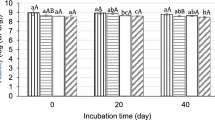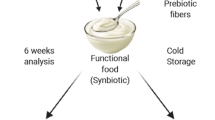Abstract
Fermented milk products were made using a probiotic strain of human origin, Lactobacillus acidophilus n.v. Er2 317/402 strain Narine. The effects of the strain on the texture, rheology, microstructure, and volatile profiling of fermented milk products over a period of 25 days under refrigerated storage conditions were investigated using steady and dynamic rheological tests, confocal laser scanning microscopy (CLSM), and headspace solid-phase microextraction gas chromatography mass spectrometry, respectively. CLSM images confirmed that exopolysaccharides (EPSs) from Narine were large in size and interacted with proteins. EPSs (50 mg) were obtained after 8 h of incubation. Volatome profiling of Narine fermented milk revealed 15 volatile compounds, including 2-heptanone, 2-nonanone, acetoin, isobutyric acid, isovaleric acid, and 2-phenylethanol. EPSs produced from L. acidophilus n.v. Er2 317/402 strain Narine gave the fermented milk a smooth ropy texture. The natural, soft-bodied, drinkable, and pleasant flavor of Narine makes it an attractive food ingredient.
Similar content being viewed by others
References
FAO/WHO (2006) Probiotics in Food. Health and Nutritional Properties and Guidelines for Evaluation, FAO Food and Nutritional Paper No.85: ISBN 92-5-105513-0.
De Vuyst, L. and B. Degeest (1999) Exopolysaccharides from lactic acid bacteria: Technological bottlenecks and practical solutions. Macromol. Symp. 140: 31–41.
Tomas, M. S., M. Clandia-Otero, V. Ocana, and M. Elena Nader-Macias (2000) Production of antimicrobial substances by lactic acid bacteria I: Determination of hydrogen peroxide. Methods Mol. Biol. 268: 337–346.
Hassan, A. N., J. F. Frank, and M. Elsoda (2003) Observation of bacterial exopolysaccharide in dairy products using cryo-scanning electron microscopy. Int. Dairy J. 13: 755–762.
Hidalgo-Cantabrana, C., B. Sanchez, C. Milani, M. Ventura, A. Margolles, and P. Ruas-Madiedo (2014) Genomic overview and biological functions of exopolysaccharide biosynthesis in Bifidobacterium spp. Appl. Environ. Microbiol. 80: 9–18.
Fanning, S., L. J. Hall, M. Cronin, A. Zomer, J. MacSharry, D. Goulding, M. O’Connel-Motherway, F. Shanahan, K. Nally, G. Dougan, and D. van Sinderen (2012) Bifidobacterial surface-exopolysaccharide facilitates commensal-host interaction through immune modulation and pathogen protection. Proc. Natl. Acad. Sci. USA 109: 2108–2113.
Akopyan, G., R. Madoyan, E. Dilanyan, and K. Kanetani (2004) Therapeutic effects of L. acidofilus n.v. Er-2 strain 317/402 “Narine”. Milk Sci. 53: 35–63.
Anisimova, T. I. and R. A. Arakelyan (2002) Bacterial strain L. acidophilus n.v Er-2 strain 317/402 Narine AAA used in the production of preparations and of dietetic, therapeutic and prophylactic products for treating dysbacteriosis and the consequences thereof. Euorpean Patent 1 186 654 A1.
Mkrtchyan, H., S. Gibbons, S. Heidelberger, M. Zloh, and K. H. Limaki (2010) Purification, characterisation and identification of acidocin LCHV, an antimicrobial peptide produced by Lactobacillus acidophilus n.v. Er 317/402 strain Narine. Int. J. Antimicrob. Ag. 35: 255–260.
Charchoghlyan, H., H. Kwon, D. J. Hwang, J. S. Lee, J. Lee, and M. Kim (2016) Inhibition of Cronobacter sakazakii by Lactobacillus acidophilus n.v. Er2 317/402. Kor. J. Food Sci. Anim. Resour. 36: 635–640.
Ismail, B. and K. M. Nampoothiri (2010) Exopolysaccharide production and prevention of syneresis in starch using encapsulated probiotic Lactobacillus plantarum. Food Technol. Biotech. 48: 484–489.
Penna, A. L. B., K. Sivieri, and M. N. Oliveira (2001) Relation between quality and rheological properties of lactic beverages. J. Food Eng. 49: 7–13.
Pan, D. D., Z. Wu, T. Peng, X. Q. Zeng, and H. Li (2014) Volatile organic compounds profile during milk fermentation by Lactobacillus pentosus and correlations between volatiles flavor and carbohydrate metabolism. J. Dairy Sci. 97: 624–631.
Ruas-Madiedo, P. and C. G. de los Reyes-Gavilan (2005) Invited Review: Methods for the screening, isolation, and characterization of exopolysaccharides produced by lactic acid bacteria. J. Dairy Sci. 88: 843–856.
Dubois, M., K. A. Gilles, J. K. Hamilton, P. A. Rebers, and F. Smith (1956) Colorimetric method for determination of sugar and related substances. Anal. Chem. 28: 350–356.
Zacarchenco, P. B. and S. Massaguer-Roig (2006) Properties of Streptococcus thermophilus fermented milk containing variable concentrations of Bifidobacterium longum and Lactobacillus acidophilus. Braz. J. Microbiol. 37: 338–344.
Dowling, N. E. (1999) Mechanical behavior of Materials: Engineering methods for deformation, fracture and fatigue. 2nd ed., pp. 443–445. Prentice Hall, NJ, USA.
Hassan, A. N., J. F. Frank, and M. Elsoda (2003) Observation of bacterial exopolysaccharide in dairy products using cryo-scanning electron microscopy. Int. Dairy J. 13: 755–762.
Hassan. A. N., J. F. Frank, and K. B. Qvist (2002) Direct observation of bacterial exopolysaccharides in dairy products using confocal scanning laser microscopy. J. Dairy Sci. 85: 1705–1708.
Dos Santos, M. S., E. Martendal, and E. Carasek (2011) Determination of THMs in soft drink by solid-phase microextraction and gas chromatography. Food Chem. 127: 290–295.
Guggisberg, D., J. Cuthbert-Steven, P. Piccinal, U. Butikofer, and P. Eberhard (2009) Rheological, microstructural and sensory characterization of low-fat and whole milk set yoghurt as influenced by inulin addition. Int. Dairy J. 19: 107–115.
Ciron, I. E., V. L. Gee, A. L. Kelly, and M. A. E. Auty (2011) Effect of microstructural of heat-treated milk on rheology and sensory properties of reduced fat yoghurt. Food Hydrocoll. 25: 1470–1476.
Petry, S., S. Furlan, M. J. Crepean, J. Cerning, and M. Desmazeand (2000) Factors affecting exocellular polysaccharide production by Lactobacillus delbrueski subsp. bulgaricus grown in a chemically defined medium. Appl. Environ. Microbiol. 66: 3427–3431.
Palomba, S., S. Cavella, E. Torrieri, A. Piccolo, P. Mazzei, G. Blaiotta, and V. Ventorino, and O. Pepe (2012) Polyphasic screening, homopolysaccharide composition, and viscoelastic behavior of wheat sourdough from a Leuconostoc lactis and Lactobacillus curvatus exopolysaccharide-producing starter culture. Appl. Environ. Microbiol. 78: 2737–2747.
Penna, A. L. B., K. Sivieri, and M. N. Oliveira (2001) Relation between quality and rheological properties of lactic beverages. J. Food Eng. 49: 7–13.
Folkenberg, D. M., P. Dejmek, A. Skriver, H. S. Guldager, and R. Ipsen (2006) Sensory and rheological screening of exopolysaccharide producing strains of bacterial yoghurt cultures. Int. Dairy J. 16: 111–118.
Hassan, A. N., J. F. Frank, K. A. Schmidt, and S. I. Shalabi (1996) Rheological properties of yogurt made with encapsulated nonropy lactic cultures. J. Dairy Sci. 79: 2091–2097.
Florencia, F. S. (2013) Rheology of spreadable goat cheese made with autochthonous lactic cultures different in their ability to produce exopolysaccharide. Food Sci. Technol. 33: 233–238.
Tabilo-Munizaga, G. and G. V. Barbosa-Canovas (2005) Rheology for the food industry. J. Food Eng. 67: 147–156.
Vaningelgem, F., M. Zamfir, F. Mozzi, T. Adriany, M. Vancanneyt, J. Swings, and L. D. Vuyst (2004) Biodiversity of exopolysaccharides produced by Streptococcus thermophiles strains is reflected in their production and their molecular and functional characteristics. Appl. Environ. Microbiol. 70: 900–912.
Krzeminski, A, K. Groβhable, and J. Hinrichs (2011) Structural properties of stirred yoghurt as influenced by whey proteins. LWT-Food Sci. Technol. 44: 2134–2140.
Winny, R. and H. N. Mishra (2011) Scientific and technical aspects of yogurt aroma and taste: A Review. Compr. Rev. Food Sci. Food Saf. 10: 208–220.
Cheng, H. (2010) Volatile flavor compounds in yogurt: A review. Crit. Rev. Food Sci. 50: 938–950.
Routray, W. and H. N. Mishra (2011) Scientific and technical aspects of yogurt aroma and taste: A review. Compr. Rev. Food Sci. Food Saf. 10: 208–220.
Author information
Authors and Affiliations
Corresponding author
Rights and permissions
About this article
Cite this article
Charchoghlyan, H., Bae, JE., Kwon, H. et al. Rheological properties and volatile composition of fermented milk prepared by exopolysaccharide-producing Lactobacillus acidophilus n.v. Er2 317/402 strain Narine. Biotechnol Bioproc E 22, 327–338 (2017). https://doi.org/10.1007/s12257-017-0065-8
Received:
Revised:
Accepted:
Published:
Issue Date:
DOI: https://doi.org/10.1007/s12257-017-0065-8




